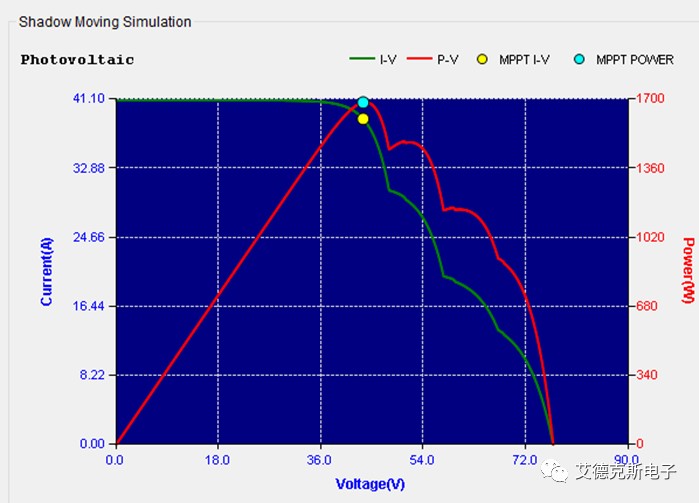Choose the right equipment, you can easily complete the simulation of photovoltaic multi-peak characteristic curves!
At present, the global photovoltaic industry is still in full swing. Technological advancements such as improving power generation efficiency and reducing power generation costs have become new industry drivers and development directions. The study of photovoltaic output characteristics under complex conditions plays a decisive role in improving power generation efficiency.
Photovoltaic output characteristic curve - multi-peak curve
Photovoltaic module is a highly nonlinear DC power supply, and its output electrical characteristics are mainly affected by other factors such as illumination amplitude, operating temperature, and wind speed. A hot spot effect occurs when the surface of a photovoltaic array is partially shaded. In order to prevent solar cells from being damaged due to local overheating due to the hot spot effect, bypass diodes are usually connected in parallel in the circuit. However, the introduction of bypass diodes will result in multi-peak output of photovoltaic arrays working under partial shadow lighting conditions.
Photovoltaic module is a highly nonlinear DC power supply, and its output electrical characteristics are mainly affected by other factors such as illumination amplitude, operating temperature, and wind speed. A hot spot effect occurs when the surface of a photovoltaic array is partially shaded. In order to prevent solar cells from being damaged due to local overheating due to the hot spot effect, bypass diodes are usually connected in parallel in the circuit. However, the introduction of bypass diodes will result in multi-peak output of photovoltaic arrays working under partial shadow lighting conditions.
The significance of simulating a multi-peak curve
The multi-peak characteristic of the PV curve under local shadows makes the grid connection cause certain interference to the tracking of the maximum power point. The traditional maximum power point tracking algorithm is no longer effective, and cannot effectively distinguish global peaks and local peaks, and cannot track the real maximum power point. Moreover, the utilization rate of light energy by photovoltaic modules is reduced, resulting in a significant reduction in system output power, resulting in waste of resources. Therefore, simulating the multi-peak output characteristics of photovoltaic modules under partial shading conditions is of great significance for testing devices with MPPT functions such as inverters, micro-inverters, and power optimizers in photovoltaic systems.
ITECH test solution
Under partial shading conditions, the nonlinear characteristics of the internal resistance of the photovoltaic array will be more complicated, causing users who need to verify the MPPT algorithm to establish complex photovoltaic array simulations. ITECH's SAS1000 photovoltaic simulation software provides cloud cover dynamic simulation function in addition to curve editing, which can simulate multi-peak output characteristic curves under partial shadow conditions with only a few simple steps. Users can select the number of series and parallel solar panels to change the size of the relevant parameters of the PV curve, edit the different light intensities of cloud cover, and move changes to track the maximum power point under different conditions. Compared with the simulation model built by the customer or using other photovoltaic simulators, the test steps are simplified, the test time is saved, and the test efficiency is improved.

SAS1000 software cloud shade dynamic simulation function editing interface


PV multi-peak curve simulated by SAS1000 software
SAS1000 software with different specifications and characteristics photovoltaic power supplies can be used as a solar simulator to provide support for system simulation and core equipment testing of power systems such as micro-grids and distributed photovoltaics. SAS1000M multi-channel photovoltaic simulation software can support simultaneous control of 20 independent photovoltaic simulation outputs to achieve more complex array simulations.
ITECH photovoltaic simulation source adopts a combination of software and hardware, and according to the requirements of different power levels such as string type and micro-inverter in the photovoltaic industry, it is equipped with professional hardware to obtain optimal testing capabilities.
●The centralized or string inverter can choose IT6000C series bidirectional DC power supply. The voltage of IT6000C series can reach 2250V, and the power can reach 2MW after paralleling. It has the characteristics of high power density and can be tested with SAS1000/SAS1000M;
●Low power string inverter and power optimizer can choose IT-M3900C SAS or IT-M3600 power supply. IT-M3900C SAS is a model specially designed for photovoltaic simulation applications under the IT-M3900C series, with 1U6kW ultra-high power density. IT-M3600 is with small size of only 1U half rack, and its power level of 200W/400W/800W is suitable for single-board simulation.
●Aiming at the more demanding micro-inverter testing requirements, a new generation of IT-N2100 series high-speed dedicated photovoltaic simulation power supply will be launched in 2023.

Home photovoltaic energy storage system test framework and scheme
At the same time, ITECH also provides full four-quadrant power supply products such as IT7900P high-performance grid simulator and IT7900 grid simulator, which can perform on-board and off-grid inspections of new energy components such as photovoltaic inverters, energy storage PCS, and bidirectional on-board chargers BOBC. For more new energy testing solutions, please visit ITECH website www.ichate.com.






